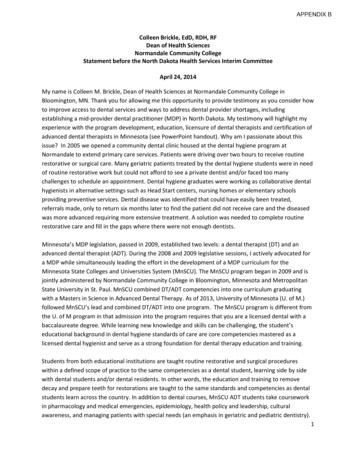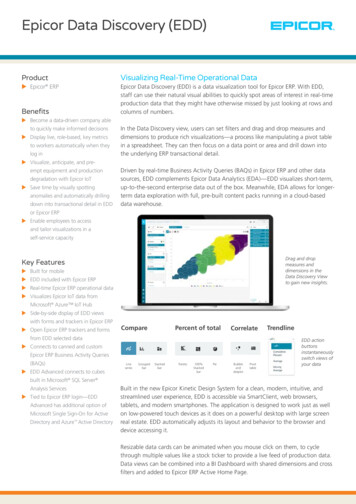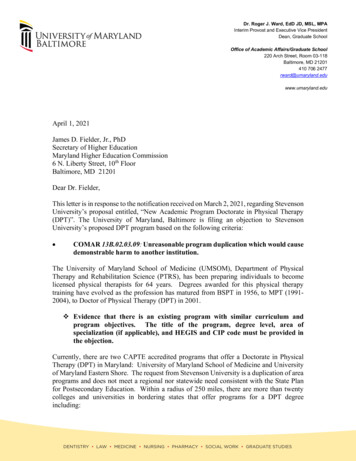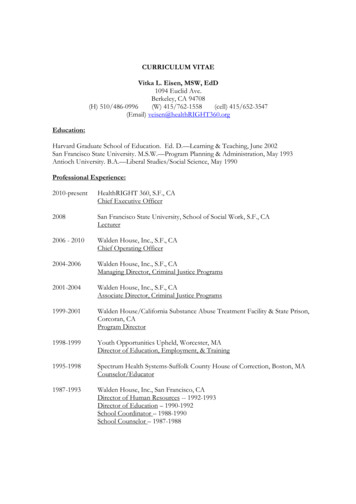
Transcription
APPENDIX BColleen Brickle, EdD, RDH, RFDean of Health SciencesNormandale Community CollegeStatement before the North Dakota Health Services Interim CommitteeApril 24, 2014My name is Colleen M. Brickle, Dean of Health Sciences at Normandale Community College inBloomington, MN. Thank you for allowing me this opportunity to provide testimony as you consider howto improve access to dental services and ways to address dental provider shortages, includingestablishing a mid-provider dental practitioner (MDP) in North Dakota. My testimony will highlight myexperience with the program development, education, licensure of dental therapists and certification ofadvanced dental therapists in Minnesota (see PowerPoint handout). Why am I passionate about thisissue? In 2005 we opened a community dental clinic housed at the dental hygiene program atNormandale to extend primary care services. Patients were driving over two hours to receive routinerestorative or surgical care. Many geriatric patients treated by the dental hygiene students were in needof routine restorative work but could not afford to see a private dentist and/or faced too manychallenges to schedule an appointment. Dental hygiene graduates were working as collaborative dentalhygienists in alternative settings such as Head Start centers, nursing homes or elementary schoolsproviding preventive services. Dental disease was identified that could have easily been treated,referrals made, only to return six months later to find the patient did not receive care and the diseasedwas more advanced requiring more extensive treatment. A solution was needed to complete routinerestorative care and fill in the gaps where there were not enough dentists.Minnesota’s MDP legislation, passed in 2009, established two levels: a dental therapist (DT) and anadvanced dental therapist (ADT). During the 2008 and 2009 legislative sessions, I actively advocated fora MDP while simultaneously leading the effort in the development of a MDP curriculum for theMinnesota State Colleges and Universities System (MnSCU). The MnSCU program began in 2009 and isjointly administered by Normandale Community College in Bloomington, Minnesota and MetropolitanState University in St. Paul. MnSCU combined DT/ADT competencies into one curriculum graduatingwith a Masters in Science in Advanced Dental Therapy. As of 2013, University of Minnesota (U. of M.)followed MnSCU’s lead and combined DT/ADT into one program. The MnSCU program is different fromthe U. of M program in that admission into the program requires that you are a licensed dental with abaccalaureate degree. While learning new knowledge and skills can be challenging, the student’seducational background in dental hygiene standards of care are core competencies mastered as alicensed dental hygienist and serve as a strong foundation for dental therapy education and training.Students from both educational institutions are taught routine restorative and surgical procedureswithin a defined scope of practice to the same competencies as a dental student, learning side by sidewith dental students and/or dental residents. In other words, the education and training to removedecay and prepare teeth for restorations are taught to the same standards and competencies as dentalstudents learn across the country. In addition to dental courses, MnSCU ADT students take courseworkin pharmacology and medical emergencies, epidemiology, health policy and leadership, culturalawareness, and managing patients with special needs (an emphasis in geriatric and pediatric dentistry).1
The clinical component of a DT/ADT’s education provides opportunities to serve all population groups.MnSCU students are provided extended campus rotations through a Community Dental Care Clinic thatserves patients from ethnicities all over the globe; Hennepin County Medical Center for special needs,pediatric and oral surgery experiences; Apple Tree Dental nursing homes for the geriatric and medicallycompromised patient care; and Children's Dental Services to serve children and pregnant mothers.These experiences allow students the opportunity to work directly with populations they will serve upongraduation.Graduates are required to pass a patient-based clinical examination that is based on the examinationdental students must also take for licensure. This examination is conducted by the Central RegionalDental Testing Service. The exam evaluators are unaware as to which patients are treated by a dentalstudent or a DT student, holding both students to the same evaluation standards. This exam validatesthat in their defined scope of practice, DTs are educated to the same level of a dentist. It is not untilafter 2000 hours of practice under indirect supervision of a dentist and passing a certificationexamination issued by the Minnesota Board of Dentistry that a licensed DT is credential as an ADT. Thisallows ADTs to perform the additional services of an oral evaluation, assessment, formulation of anindividualized treatment plan, extractions of permanent moderately to severely mobile teeth and theability to provide, dispends and administer antibiotics, analgesics and anti-inflammatories under generalsupervision (no dentist on site) within the protocols established by dentist and written in a collaborativemanagement agreement that both the dentist and ADT sign.The broad range of primary care services in Minnesota’s statute allows ADTs to improve access to carefor rural and underserved populations and increases entry points for patients into the oral health caredelivery system. The ADT is not a replacement for a dentist, but is intended to extend the reach of thedentists. They make it easier for patients to access routine care and make it more affordable forunderserved populations to obtain high quality oral health services. Although dental disease ispreventable, there are populations with rampant untreated decay and periodontal (gum) diseases. TheADTs ability to provide preventive care and disease treatment can be extended to outreach locations bycollaborating with a dentist when providing care. Working within the protocols outlined in acollaborative management agreement with a dentist, patients are referred to a dentist when they needthe services beyond the ADTs scope of practice. This allows ADTs the ability to work in schools,community centers, nursing homes, virtually any place where there are unmet, while still being able torefer more complex cases to a dentist. Opening access to dental care and delivering care directly to apatient who has challenges making it to a private office results in cost-savings in the public healthcaresystem.While Minnesota is the first state to license a MDP in the United States, Alaska and more than 50 othercountries have educated and utilized mid-level dental providers safely and effectively for decades.Preliminary collection of data to evaluate the DT/ADT was completed by the Minnesota Department ofHealth and Board of Dentistry. A report, “Early Impact of Dental Therapists in Minnesota” was presentedto the Minnesota legislature in February 2014. Preliminary results from the report:1. Clinics employing DT/ADTs see more patients and most are on public programs and areunderserved2
2.3.4.5.DT/ADTs improve efficiency of clinics, allowing dentists to handle more complex proceduresDT/ADTs have reduced wait times and travel distances for patientsDT/ADTs produce direct cost savings to dental clinicsDental clinics use most savings from DT/ADTs to see more public program and underservedpatients6. No quality or safety concerns7. Further research is needed, since the program is new and the number of DT/ADTs relativelysmall at this point (though growing)From my vantage point, the acceptance level of MnSCU ADTs is growing, even among the strongeropponents of this legislation. At this time the ADT is being integrated as a key new member of the dentalteam. All of the MnSCU graduates have been employed and at this time, all ADTs in Minnesota are duallicensed as both a dental hygienist and a dental therapist.What can be learned from Minnesota? First, MDPs offer quality, safe, and cost-effective care toMinnesotans who struggle to find care. Second, in addition to a dentist, MDPs provide another entrypoint for a patient to access the dental system. In the traditional practice setting, the only way a patientcould seek dental treatment was to first receive an exam from a dentist. In Minnesota, it is now possiblefor ADTs to assess/evaluate and treat dental pain without the patient first having to see a dentist. Thismeans a patient can get needed treatment quicker and more efficiently, while also providing them away to connect with a dentist if they need more complex procedures. Third, this also provides anothercareer pathway for dental hygienists while giving dentists more flexibility to treat people that struggle toget care.Too many people struggle to enter the oral healthcare system and a MDP can be that additional entrypoint to extend the arm of dentists to assist those who desperately need care. In addition to openingaccess, MDPs provide safe, quality, effective dental care for those most in need. For years, we havesearched unsuccessfully for ways to improve access to dental care for the underserved. As with dentalhygienists, who are dentistry’s valued and trusted “preventive specialists”, health promotion anddisease prevention remain the primary focus of ADTs. Yet, until we care for patients who are far beyondpreventive services, we are losing ground with each passing day. The private practice model of dentistryas it exists now works for middle to upper class individuals, but it’s clearly not working for everyone.MDPs allow both private practice and public health dentists alike to extend their care. It’s my hope thatNorth Dakota puts words into action and passes legislation to make MDPs a reality.Thank you for your time and consideration.Colleen M. Brickle EdD, RDH, RFDean of Health SciencesNormandale Community College9700 France Ave SBloomington, MN 55431952-358-8158 (Direct)colleen.brickle@normandale.edu3
Minnesota’s New Mid-Level DentalPractitionersDental Therapist andAdvanced Dental TherapistResponding to Access to Prevention and Access to Care
Minnesota GoalsFor the Mid-level Practitioners Improve access by filling gaps where there arenot enough dentistsDentists are vital to the model Designed NOT to replace or compete withdentistsPart of a broader strategy to improve access Not the silver bullet2
Curriculum DevelopmentBackgroundNew Program Application The Advisory Committee Roles: Requirements and Process for Admission Curriculum Development Legislative Process Dentist members of the Advisory Committeeare actively involved in the educational processExperience teaching dental students Background in pediatric, geriatric, special needs,and hospital dentistry
Competencies and Domains Program Competency Development(2006-2009): ADHA Competencies for the Advanced DentalHygiene PractitionerADEA Competencies for the New General DentistCODA Standards for the Dental Education ProgramsOther Standards and Competency Documents(2011-2014) MN Board of Dentistry Standards and CompetenciesCommunity Catalyst Standards for Dental TherapyCODA Draft Standards for Dental Therapy
New Program ApplicationRequired Components Description of the Proposed ProgramDocumented Need for the ProgramOccupational/Professional need Student interest Resources Facilities, Personnel, EquipmentExternal Relations/Collaborations Partnerships , grants with community partners, andgifts and donations
New Program Application cont. Budget and Financial Information Projectedenrollment , anticipated revenues,personnel needs and expenditures, facilities ormajor equipment needs Program Curriculum Admissions,program outcomes andrequirements, courses, credits for eachcourse/program, common course outlines,fact sheets, application process
New Program Application cont. Supporting Documentation InstitutionsCurriculum Committee minutes Occupational/Professional demand data Student interest data Faculty Vitae Evidence of business/industry support Copies of agreements with institutions Evidence of external review Letters of Support
State Law Parameters Dental Therapist (DT)Services allowed under general supervision Services allowed under indirect supervision asdefined in a Collaborative Management Agreement(CMA) Baccalaureate Degree Advanced Dental Therapist (ADT)All DT services under general supervision Additional services allowed under generalsupervision as defined in a CMA Masters Degree
Educational InstitutionsOffering ProgramsMnSCUMetropolitan State andNormandale Community CollegeUniversity of MinnesotaSchool of Dentistry
Master of ScienceAdvanced Dental TherapyCurriculum leads to dental therapy licensure andcertification in advanced dental therapy
MnSCUCombined DT/ADT ProgramProgram is distinctive: Experienced dental hygienists, licensed andpracticing in the professionStudents have already mastered a wide range ofcompetenciesEducated to have sound public health perspectiveas well as perform specific oral proceduresDual licensed: both as a dental therapist and adental hygienist
Courses in the Curriculum Interprofessional/Public Health EmphasisDesigning for Quality Community-Based Intercultural Communication Epidemiology Health Policy and Leadership Oral Health Care Practitioner (DT/ADT)Health Assessment and Oral Diagnostic Reasoning Pharmacology Principles of Clinical Application Management of Dental and Medical Emergencies
Courses in the Curriculum cont. Oral Health Care Practitioner (DT/ADT) cont.Community-Based Primary Oral Healthcare I Community-Based Primary Oral Healthcare II Community-Based Primary Oral Healthcare III Community-Based Primary Oral Healthcare IV Advanced Specialty Practices Community-Based Primary Oral Healthcare V Advanced Community Specialty Externship Comprehensive Community-Based Capstone Continuing Clinical Competency Skills Course Advanced ADT Credentialing Refresher Course
Didactic, Lab and/or ClinicalExperiencesProgram TotalsTwenty-four months** 342317851,350under curriculum redesignProposing a sixteen month program
Program Costs for Students Current tuition/fees for Metropolitan StateUniversity courses: Books, lab fees, and equipment are not includedin the fee above 435 per credit (fall 2013) 2,000 fee for the lab/clinical and externship courses(subject to change)CRDTS examination 2,500 Application and site feeTotal cost of program: Approximately 36,000
Clinical ExperiencesClinical experiences are vast and work in settingswith diverse and underserved populations Metropolitan State University Normandale Community College New Clinic in MaplewoodUse of lab and clinicCommunity Clinic PartnersChildren’s Dental Services Hennepin County Medical Center Community Dental Care Apple Tree Dental Other sites being explored
Clinical Licensure ExaminationCRDTS Laboratory Requirements (simulation)Stainless steel crown preparation (permanentdentition) Stainless steel crown adaptation, adjustment, andcementation (primary dentition) Prefabricated resin crown preparation (permanentdentition) Pulpotomy access opening (primary dentition) Clinical RequirementsClass II amalgam preparation and restoration Class III composite preparation and restoration
ADT CertificationRequired to complete these requirements Be licensed as a Dental TherapistSubmit proof of 2000 hours of practice of dentaltherapyGraduate from a Master’s Degree program inAdvanced Dental TherapyPass a Board of Dentistry approved examdemonstrating competency under the advancedscope of practiceSubmit an application for certification
Employment Locations Two cohorts of graduatesEmployed and working on2,000 hours of dentaltherapy scope of practicenecessary for advanceddental therapycredentialingBoard of Dentistrydeveloped and improvingthe credentialing process
Assurance Plan in MinnesotaFor a competent workforce and ensuring access to care Board of Dentistry rule making and programreview processClinical and credentialing examinationsProgrammatic accreditationEvaluation process by the MinnesotaDepartment of HealthMinnesota Department of Human ServicesOngoing policy and advocacy efforts
Thank youColleen M. Brickle EdD, RDH, RFNormandale Community Collegecolleen.brickle@normandale.edu952-358-8158
In 2005 we opened a community dental clinic housed at the dental hygiene program at Normandale to extend primary care services. Patients were driving over two hours to receive routine restorative or surgical care. Many geriatric pat











